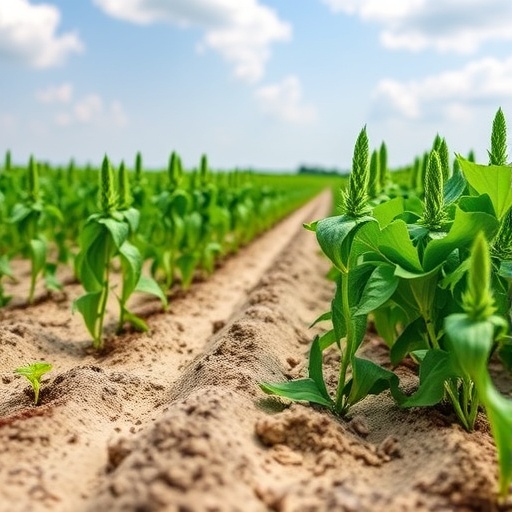In an era where climate change poses increasing threats to global food security, the quest to understand and enhance plant resilience to environmental stresses has never been more critical. This challenge is particularly acute for root systems—the hidden half of the plant that anchors it and acquires vital water and nutrients from the soil. Despite their importance, roots have remained enigmatic, largely due to the difficulty in precisely characterizing their complex subterranean architectures. A groundbreaking new study from La Trobe University offers a transformative approach by applying advanced machine learning techniques to decode latent traits in plant root systems, marking a significant leap forward in plant phenotyping.
Traditional methods for analyzing root traits have relied heavily on human-defined geometrical descriptors such as root length, diameter, and branching patterns. While useful, these parameters can miss the subtle and intricate spatial patterns that underpin a plant’s ability to adapt to stresses like drought. With drought conditions intensifying worldwide, there is a mounting urgency to identify root traits that confer drought tolerance in crops like wheat, a staple feeding billions globally. Recognizing this, a multifaceted team led by Mirza Shoaib and Surya Kant has developed an innovative computational framework known as Algorithmic Root Traits (ART), which leverages an ensemble of unsupervised machine learning algorithms to reveal these hidden root features from digital imagery.
The ART framework ingeniously combines nine unsupervised machine learning algorithms, including a bespoke algorithm designed specifically to detect and quantify dense root clusters in root images. By analyzing these clusters, ART extracts 27 distinct spatial features per image that collectively capture the complexity of root architecture in ways far beyond traditional morphometrics. This approach essentially allows the model to “see the unseen”—uncovering latent patterns in root organization that are invisible to the human eye but critical to understanding drought tolerance mechanisms.
To validate ART’s efficacy, the researchers applied it to a diverse set of wheat genotypes exhibiting varying degrees of drought resistance. These genotypes were physiologically characterized under drought stress using comprehensive metrics such as stomatal conductance, relative water content, and tiller number, which were then statistically analyzed to rank the plants by drought tolerance. Unsupervised clustering based on these metrics revealed robust separations between tolerant and susceptible groups, providing a biological benchmark for the machine learning classifications.
Parallel to this physiological characterization, imaging data of root systems were subjected to both traditional Root Trait (TRT) analysis and the newly developed ART extraction. While TRTs focused on established morphology descriptors, ART intensively quantified spatial cluster properties, capturing deeper architectural complexity. These two sets of traits were leveraged independently and in combination to train supervised classification models including Random Forest and CatBoost classifiers, trained to predict drought tolerance status.
Results from this integrative modeling unveiled that ART features alone outperformed traditional metrics, achieving a remarkable 96.3% classification accuracy with an area under the receiver operating characteristic curve (ROC AUC) of 0.997. This was a significant improvement over the 85.6% accuracy and 0.927 ROC AUC obtained from TRT-only models. Moreover, combining ART and TRT data yielded the highest accuracy of 97.4% and ROC AUC of 0.998, affirming that latent root traits, when complemented by traditional descriptors, provide the most robust drought tolerance predictors.
Crucially, the researchers evaluated the generalizability of their combined model by testing it on an independent dataset comprising unseen genotypes, where it maintained high performance with 91% accuracy and 0.96 ROC AUC. This external validation underscores the biological relevance and scalability of ART-derived traits, demonstrating their potential as a reliable screening tool in breeding programs targeting climate-resilient crops.
The biological insights uncovered by ART highlight important physiological adaptations underlying drought tolerance, such as deeper root growth and targeted biomass allocation to root clusters that maximize water uptake. These patterns, which escaped detection by conventional analyses, underscore the value of leveraging algorithmic approaches to map complex root spatial organization in phenotyping pipelines.
Beyond immediate applications in drought resilience screening, the ART framework represents a new paradigm for extracting latent biological information from plant imagery. Its modular design can seamlessly integrate with complementary omics datasets—including genomics and metabolomics—to unravel genetic loci and metabolic pathways underpinning adaptive root traits. Furthermore, the conceptual approach is extensible to other plant organs and phenotypes, holding promise for detecting subtle disease symptoms or developmental variations through image pattern recognition.
This fusion of machine learning with plant phenotyping marks a milestone in agricultural science, offering a scalable, precise, and objective method to probe hidden root traits and accelerate breeding strategies amidst climate uncertainty. As global food systems grapple with environmental challenges, tools like ART herald a new frontier in understanding and harnessing plant resilience at unprecedented detail.
Funded by Agriculture Victoria Research and hosted within the interdisciplinary journal Plant Phenomics, this study reflects a growing recognition that the future of crop improvement lies at the intersection of biology and data science. By empowering researchers to “see beyond the visible,” ART paves the way for breeding crops that can thrive in an increasingly water-limited world.
In summary, the pioneering ART framework exemplifies how integrating cutting-edge machine learning with rigorous physiological evaluation redefines plant phenomics. It elevates root system analysis from traditional geometric descriptions to complex spatial algorithms, unlocking latent trait information vital for understanding drought tolerance. The high accuracy and validation of ART-based models highlight their transformative potential as scalable tools for plant breeding and phenotypic screening, ultimately contributing to global food security and sustainable agriculture.
Subject of Research: Not applicable
Article Title: Seeing the unseen: A novel approach to extract latent plant root traits from digital images Author links open overlay panel Mirza Shoaib a b
News Publication Date: 9-Jul-2025
References:
DOI: 10.1016/j.plaphe.2025.100088
Keywords: Plant sciences, Agriculture, Engineering




